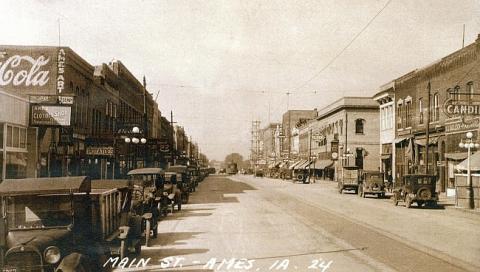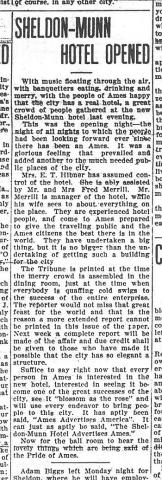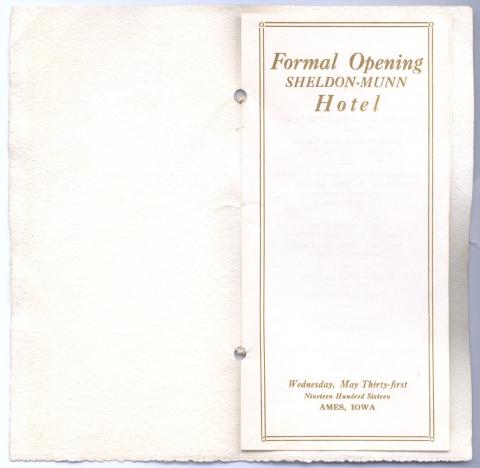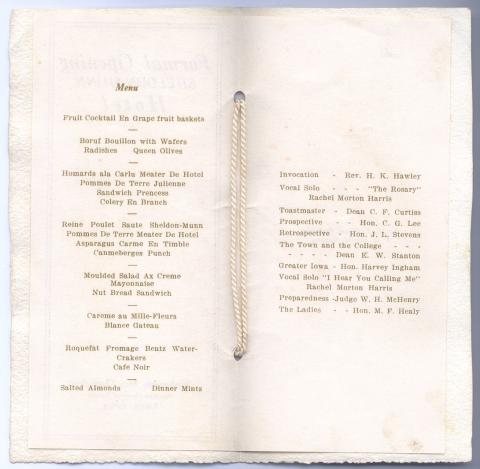After twelve years of considering proposals for a new hotel or the extensive remodeling of one of the old existing hotels, a group of Ames business men organized the Ames Improvement Company to carry out the community's desire to have a hotel that would meet not only immediate needs, but meet the future needs of a growing city. A successful venture was finally assured. Parley Sheldon, banker and perennial mayor of Ames, H. L. and A. H. Munn, lumberyard owners, contracted for the hotel's construction in June of 1915. Sheldon and the Munns remained the owners until a major interest was sold to Tangney-McGinn Hotels in 1926. The Ames Improvement Association was involved in arranging for leasing and management.
Ground was broken in late 1915 and the Sheldon-Munn Hotel was formally opened on May 31, 1916. Dean C. F. Curtiss was toastmaster on the occasion of a formal dinner that evening. Dean E. W. Stanton spoke on The Town and the College and Harvey Ingham of the Des Moines Register spoke on Greater Iowa. There were other dignitaries on the agenda that evening too, and the new modern social and service center of Ames was very properly launched.
NEW SHELDON-MUNN HOTEL IS FINEST IN MIDDLE WEST
Ames Evening Times, June 6, 1916
Beautifully furnished, perfectly equipped and elaborately decorated, it represents final word in hotels
CAPABLE MANAGEMENT
Mrs. E. T. Hibner and Mr. and Mrs. Merrill are capable hotel people of long experience – capacity business.
Towering four stories in the air at the corner of Main street and Kellogg avenues, the palatial new $150,000 Sheldon-Munn hotel represents the final word known to modern hotel building and equipping. Words of praise for the completeness of the building and the beauty of the furnishings have been expressed by every visitor who has entered its doors, but it is only from thorough investigation of the hotel and a talk with the management that an idea can be gained as to what a truly wonderful structure it is.
Seventy-two guest rooms, a banquet hall, a dining room, a private dining room, a grill room, large sample rooms and the most beautiful lobby of any hotel in the middle west combine to entertain the guests in ease and comfort.
The big banquet hall on the fourth floor is one of the show places of the hotel. It is 45x68 feet in size and is decorated in blue and gold with light fixtures and window hangings to match. The floor is said to be the finest dance floor in Iowa and when covered with a canvas makes the finest banquet hall in Iowa. Three hundred banqueters can be seated at one time in this room, which opens to the air on three sides and is possessed of perfect ventilation. Connected with the banquet hall is a serving room where the food is taken from the big elevator as it comes up from the kitchen on the main floor. A ladies parlor and gentlemen’s check rooms complete the equipment for banquet use.
FLOORS IN COLOR
The fourth floor is known as “the red floor” because of the color of the hall carpeting. The guest rooms on this floor are typical of the building. A dresser, a rocker, a writing table, and chair, a Simmons brass bed and carpetings and window hanging in harmony make the rooms attractive and home like. Each room as a closet equipped with shelves and clothes hooks and above the lavatory is a white enameled cabinet for toilet accessories. There are forty rooms with connecting bath in the building, the tubs in the bath rooms being built in and the walls being furnished in tile with blue borders and ceilings.
A telephone, hot and cold water, and two lights, one a dressing light, are to be found in every room. Every little detail that will add to the comfort of the guests has been provided in each room even down to pins, needles and shoe polishing cloths. An especially interesting feature is that the connecting rooms are so equipped with locks that the occupant of either room can lock the door between, instead of one lock holding the door fast as in most hotels.
The third floor is called “the green floor” the rooms on this floor are arranged and equipped similar to those on the other floors. It is on this floor that the private dining room is located. It is designed for parties and luncheons and is a very beautiful convenience.
On the second floor, which is known as “the Old Rose Floor,” the ladies parlor is located at the head of the stairs. The furniture on this floor is the popular tapestry, in comfortable chairs and rockers, a davenport, two writing desks, a floor lamp, a piano and an Edison.
LUXURIOUS SOUTH WING
The south wing of the second floor is the most luxurious of the entire building. At each end is located a bridal suite, the one on the west being in the Old Rose and the one on the east in blue. Old Rose and blue carpets and window hangings to match give beauty to the rooms with their white ivory twin beds. On this floor are four suites of Green Rooms and two rooms furnished with solid mahogany four poster beds. All upholstery, carpets and window hangings in these rooms are in perfect harmony.
On the second floor are the private apartments of the proprietor and manager. These consist of four rooms and bath, beautifully furnished and equipped for comfort and convenience. All of their furniture in the guest rooms is of mahogany of the finest quality. Every bed is spread with a white wool blanket and there are also in the building 100 heavy wool blankets with Sheldon-Munn in the weave. An enormous amount of linen is necessary to spread the beds and on each floor are two large linen closets where this [is] stored. The woodwork of the building is finished in mahogany and the entire structure is absolutely fire-proof.
LOBBY IS BEAUTIFUL
The lobby wherein has been spent as much as is spent in furnishing some hotels completely, is said to be unsurpassed in beauty and furnishings by any hotel in the middle west. The chairs and davenport are of genuine leather in brown. The walls and ceilings are decorated in lead and oil and blend in a harmonious and pleasing appearance. Over the cozy fire place, on the east side of the lobby is a beautiful scene done in oil. The decorating was done by Paul Seland, a Finland artist who has studied in Austria and is now in the employ of the New England Furniture and Carpet Co. of Minneapolis. He is said to be the highest salaried decorator in the Twin Cities and has a reputation gained from decorating some of the largest buildings in the country. Large lights hung in gold fixtures give added beauty to the lobby.
Opening in the north from the lobby is the dining room. Carpeted with a rich velour carpet and lighted by two large windows on the north, it is an ideal dining room. Blue velvet velour hangings with a gold frieze and solid mahogany furniture add to its attractiveness. The dining room will seat seventy-five people very comfortably and has already been taxed to capacity.
To the rear of the dining room is the big kitchen, presided over by five chefs and numerous helpers. On the east near the entrance to the dining room, is the pastry room where all of the bread and pastry to be used in the hotel, will be prepared. A huge range lines the north side of the kitchen with a big refrigerator on the south side. A feature of the kitchen of interest to the women is the electric dishwasher wherein 3,000 dishes can be washed, rinsed and dried in an hour. The dishes are of Syracuse china and are of a very pretty design.
Opening from the lobby on the west side is the Grill which will be open for business in about a week and where meals and short orders will be served.
In the basement of the building are the sample rooms, storage rooms and heating plant.
The hotel was furnished complete – by the New England Furniture and Carpet Co. of Minneapolis, one of the largest hotel outfitting concerns in the northwest. All of the furnishings are of the best quality and beautifully done. They were selected in person by Mrs. E. T. Hibner, the proprietor who has been ably assisted in the arrangements by the excellent service of this firm.
Genial Management
With such a fine hotel so perfectly equipped it only remains for capable management to make it a business success, and in that line the Sheldon-Munn has been especially fortunate. Mrs. E. T. Hibner, the proprietor and F. D. Merrill, the manager are hotel people of long experience and come from Iowa Falls with strong recommendations as to their ability.
Mrs. Hibner brings to Ames her two children Donan and Karline. She has already demonstrated her business capacity in the manner in which she has equipped and launched the hotel and will be a welcome addition to Ames business and social circles.
Mr. and Mrs. Merrill bring with them their daughter Margaret. Both will be active in the management of the hotel, and in such capable women of Mrs. Merrill and Mrs. Hibner, Manager Merrill will have valuable cooperation. Mr. Merrill has grown up in the hotel business and is well known to the traveling public. He has the happy faculties necessary for a successful manager and will be a big asset to the city.
The hotel has been crowded to capacity since the day it was opened. The rooms have been filled every night and the dining room has been overcrowded. It will be operated on both the American and European plans with rates at $2.50 to $3.50 per day. A popular feature planned for the near future is the Sunday night dinner with music.
As a home for the traveling public, a convention hall, a banquet place, and with facilities for handling dancing parties, luncheons and recitals the new Sheldon-Munn presided over by such genial people will occupy a large place in the life of Ames. To Parley Sheldon and H. L. and A. H. Munn will go everlasting praise and thanks for their great work in erecting the hotel.
HUNDREDS VISIT SHELDON-MUNN
Ames Evening Times, June 6, 1916
Get acquainted Evening is a Great Success at Ames’ New Palace Hotel.
The new Sheldon-Munn hotel threw wide its doors last night to admit the citizens of Ames on a visit of inspection. Hundreds of interested people thronged the beautiful new hostelry from basement to top floor and all expressed themselves in a manner highly complimentary to the builders and the leasee, Mrs. Hibner.
Personally conducted parties were taken the rounds of the hotel and for those who wished music was provided for dancing in the spacious and beautiful ball room. Mrs. Hibner expressed herself as highly pleased with the way in which the people of Ames showed their interest in the new hotel last evening.
The new hotel was to be the meeting place for town and college, for there was no Memorial Union then. The hotel was booked months ahead for social events, fraternity and sorority dances. Professional meetings of many kinds met there. According to Mrs. Rogers it was not uncommon for the Sheldon-Munn to be the site of a ballroom dance, a private dinner party on third, a smoker in the basement, a convention group somewhere, and a main dining room full of off the road or street guests, all at the same time in those days. In 1925 the American Legion relocated its post club room to the basement of the hotel. With its four floors of 72 fine guest rooms, the hotel provided a large ballroom on the fourth floor, a private dining room on third, various meeting rooms, sales display rooms, a four chair barber shop in the east basement, a large main dining room on first and a separate grill or coffee shop on the main street side. All dining facilities were served by the large kitchen under the direction of six full-time chefs.
Farwell T. Brown recalls Christmas dinner on December 25, 1919 when he was nine.
It was to this place that the Brown family, below, came for their Christmas dinner on December 25, 1919. Grandfather and Grandmother Brown had attained the age and family numbers had grown to the point where the Hotel provided the ideal place for that important family event that year.
A long table had been reserved for us in the main dining room. As we arrived – there were four families of us then in Ames – we were directed by way of the elevator to the second floor ladies’ parlor to await the arrival of the rest of the uncles and aunts, cousins, and, of course, the grandparents.
But I will never forget the hotel lobby that day. It was terribly cold outdoors and as we entered at the main doorway on the south side of the building, the burning log fire in the fireplace that was on the east wall of the lobby greeted us. The lobby then was much larger than today, as it included all of the area today partitioned off for the present hair salon and also the area occupied now by a barbershop. Original ceilings were high with “square” pillars that can still be seen although the very magnificent marble-looking cover has long since been removed or covered over.
Beautifully tailored drapes were a dark blue. All of the Hotel drapes in the lobby and in the dining and ballrooms were monogrammed with the letter “S.M.”
In this setting a string ensemble was playing to one side of the huge fireplace. They had several regular musicians who played every evening in the hotel. One was Fred Snyder who was an engineer with the Highway Commission at the time. Both he and his wife were accomplished violinists in Ames. Another was Harold Kramer, a pianist, who played in the Sheldon-Munn dining room for several years, then went east where he made a name for himself as an entertainer.
After the family had gathered, we were called to the dining room on the first floor, entering through the lobby. The dining room then extended to the Kellogg side and all along the alley side on the North. The dining room ceiling, like the lobby area, was high with molded plaster scroll work along the ceiling corners.
By the time the main dining room was open, on holidays and on Sunday noons all through the year, the string trio or quartet had moved out of the lobby into an elevated alcove that was built into the south wall of the room. It was reached by way of a curved staircase. There was a piano permanently installed in this “elevated orchestra pit” and dinner music was a regular feature of both weekday and Sunday dinner hours and on holidays, of course.
Christmas dinner at Grandmother’s was always complete and two kinds of pie could be assumed. The Sheldon-Munn proved to be no exception!
Before we ate, Grandfather gave the blessing but at the hotel it was something special. With the main dining room full of dining couples or groups all smaller than ours, and all around us, how would he handle it? Very simple, he just held up his hand. He was, as I recall, a rather large man, by nature the “take charge” kind. He glanced around the room as the musicians completed a selection and merely asked that “all be quiet for a moment.” He then proceeded in his natural clearly spoken manner and gave them the same kind of blessing that he was accustomed to give. And the room was hushed for a few moments – and then we were served.
Sheldon-Munn waiters were quite formal in those days. Precise in manner, they omitted no expected move in their service. The tableware at the hotel was a “lovely silver,” the tablecloths were white damask with all linen napkins. Fluted goblets were used at all special occasions. Like in the lobby, draperies were a rich blue with gold braid borders or ties with the S.M. monogram. The chairs were sturdy, I think painted gold. The multi-course dinner I could not have detailed had not Mrs. Rogers (daughter of the hotel’s first managers) shown me the 1919 printed menu for that day.
What a Christmas dinner – and all for a dollar and a half!
“The banquet was one of the finest efforts of the kind ever pulled off in Ames. The tables had been beautifully decorated and at the plate of each person was a sweet smelling jasmine. The hotel dishes were used and the S.M. monogram in gilt letters were pretty as a picture. The menus were handpainted and printed and were the work of an artist.”
“Seventy-two guest rooms, a banquet hall, a dining room, a private dining room, a grill room, large sample rooms and the most beautiful lobby of any hotel in the middle west combine to entertain the guests in ease and comfort.”
The floor is said to be the finest dance floor in Iowa and when covered with a canvas makes the finest banquet hall in Iowa. Three hundred banqueters can be seated at one time in this room, which opens to the air on three sides and is possessed of perfect ventilation.
“It would hardly do to pass through this article without calling especial attention to the office and lobby. Across the north side of the lobby an elegant office has been fixed up. Large roomy leather chairs are at every convenient point, while huge davenports fill the odd spots. A fireplace along the east side of the rooms adds a homelike appearance. The desk is of the finest material with a cigar case along the west side. In an alcove are a number of writing tables where men and women can do their correspondence without interruption. A public stenographer has her office in the lobby. A telephone system connecting the world with every room is an advantage that is seldom found in a town the size of Ames.”
“The banquet was one of the finest efforts of the kind ever pulled off in Ames. The tables had been beautifully decorated and at the plate of each person was a sweet smelling jasmine. The hotel dishes were used and the S.M. monogram in gilt letters were pretty as a picture. The menus were handpainted and printed and were the work of an artist. Those menu cards will long be preserved by the attendants as souvenirs of the occasion.”
The new hotel was to be the meeting place for town and college, for there was no Memorial Union then. The hotel was booked months ahead for social events, fraternity and sorority dances. Professional meetings of many kinds met there. According to Mrs. Rogers it was not uncommon for the Sheldon-Munn to be the site of a ballroom dance, a private dinner party on third, a smoker in the basement, a convention group somewhere, and a main dining room full of off the road or street guests, all at the same time in those days. In 1925 the American Legion relocated its post club room to the basement of the hotel. With its four floors of 72 fine guest rooms, the hotel provided a large ballroom on the fourth floor, a private dining room on third, various meeting rooms, sales display rooms, a four chair barber shop in the east basement, a large main dining room on first and a separate grill or coffee shop on the main street side. All dining facilities were served by the large kitchen under the direction of six full-time chefs.
He Climbed to the Top of Sheldon-Munn - On the Outside, That is
by Farwell T. Brown
“Human Fly will entertain Ames audience Tuesday.” That was the caption on a Tribune front page story on July 28, 1924. Just a few years ago, you will recall the story about some dare devil who climbed the Empire State building in New York City. He had failed to get any advanced permission to make the climb. That fellow used some sophisticated equipment in accomplishing his feat; also, he was in trouble with the law when he got to the top.
Billy Brine, as announced in the Tribune, did climb the Sheldon-Munn and he had everyone’s permission at the time. I was in the crowd that day, and remember it well.
Fifteen years earlier, Brine had worked on farms near Marshalltown. In 1924, while visiting in Marshalltown, he took the assignment to climb the Sheldon-Munn at his brother’s request.
A big crowd filled the street in front of the hotel. The climb was made on the Main Street side. Brine went right up the side of the building at a point above the hotel entrance. He engaged in a lot of “fanfare” and some theatrics. He used no equipment of any kind – but he did have an accomplice on the inside of the hotel. Climbing from window to window, Brine was able to climb to an open window on each floor as he moved upward. His accomplice was kept busy opening and closing windows. By pulling both window panes of each window into the down position after Brine had reached still another window sill, he could then thrust himself upward by climbing onto the tops of the respective frames.
When you are next down on Main Street, take a look at the hotel and see just how hard it would be for an ordinary man to do what he did that day. He must have had exceptional strength in his arm and leg muscles; once he got his hand on the brick window sill above him, he would literally lift himself to a point where he could wiggle into the open window space.
Brine shook the crowd up several times by pretending to slip – each time catching himself just in time. Attaining the top of the building, he proceeded then, to climb the flag pole, where he balanced himself on the gilded ball at the top. As the crowd hushed, he shouted out the name of his usual sponsor, the Chevrolet Company. “Chevrolet! Chevrolet!”, he called out. I presume that it was the Chevrolet Company that had sponsored his climb that day.
We don’t hear of “Human Flies” today, but in 1924, the Tribune story explained that Brine was one of six in the “business” at the time. Brine had been climbing for 11 years by 1924. His record had been 161 building climbs in 1921.
The success of the hotel prompted an expansion, so the lots west of the hotel were purchased in 1926. The $85,000 addition, a close match to the original structure, was built by Ames building contractor Ben Cole. When completed in February of 1927, the hotel portion had been doubled and there was room for two more, for a total of six, bays for commercial enterprises on the ground floor.




























